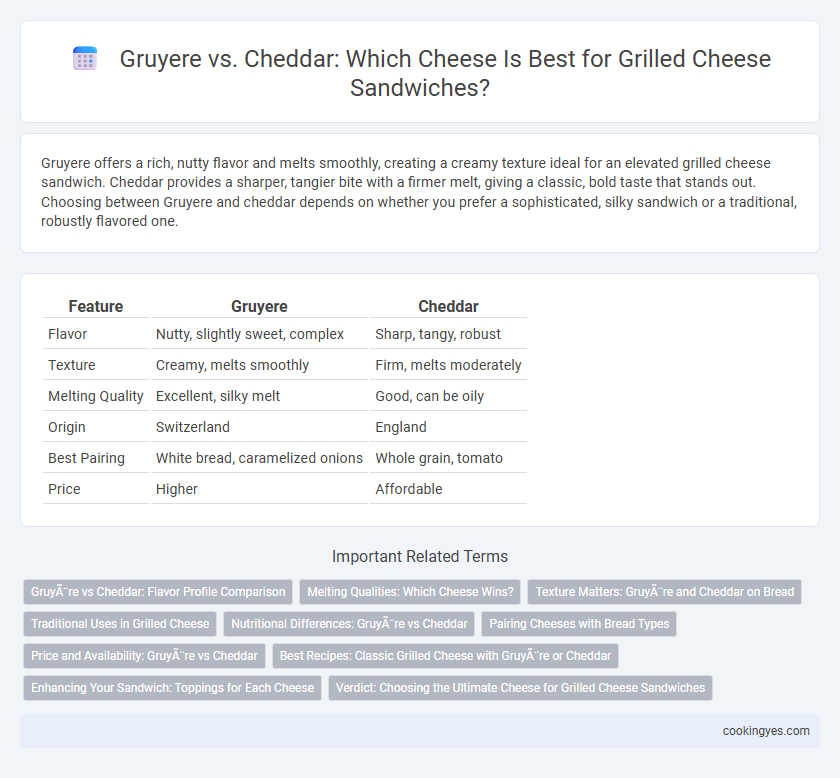Gruyere offers a rich, nutty flavor and melts smoothly, creating a creamy texture ideal for an elevated grilled cheese sandwich. Cheddar provides a sharper, tangier bite with a firmer melt, giving a classic, bold taste that stands out. Choosing between Gruyere and cheddar depends on whether you prefer a sophisticated, silky sandwich or a traditional, robustly flavored one.
Table of Comparison
| Feature | Gruyere | Cheddar |
|---|---|---|
| Flavor | Nutty, slightly sweet, complex | Sharp, tangy, robust |
| Texture | Creamy, melts smoothly | Firm, melts moderately |
| Melting Quality | Excellent, silky melt | Good, can be oily |
| Origin | Switzerland | England |
| Best Pairing | White bread, caramelized onions | Whole grain, tomato |
| Price | Higher | Affordable |
Gruyère vs Cheddar: Flavor Profile Comparison
Gruyere offers a nutty, slightly sweet flavor with a smooth, creamy texture that melts evenly, making it ideal for grilled cheese sandwiches seeking a sophisticated taste. Cheddar provides a sharper, tangier bite with a firmer texture that adds a more pronounced, robust flavor profile. The choice between Gruyere and Cheddar hinges on whether a mild, buttery melt or a strong, zesty kick is preferred in the grilled cheese experience.
Melting Qualities: Which Cheese Wins?
Gruyere offers superior melting qualities for grilled cheese sandwiches, creating a smooth, creamy texture with a slightly nutty flavor that enhances the sandwich's richness. Cheddar melts well but tends to become oily and less cohesive when heated, affecting the sandwich's consistency. For the perfect melt and balanced creaminess, Gruyere is the preferred choice.
Texture Matters: Gruyère and Cheddar on Bread
Gruyere offers a creamy, smooth melt with a slightly elastic texture that creates a luxurious, gooey experience perfect for grilled cheese sandwiches. Cheddar provides a firmer, crumbly texture that melts into a rich, sharp layer, adding a satisfying bite to the bread. Choosing Gruyere results in a silky, velvety interior, while Cheddar delivers a more structured, flavorful melt that holds well between toasted slices.
Traditional Uses in Grilled Cheese
Gruyere is favored in traditional grilled cheese sandwiches for its creamy texture and nutty, slightly sweet flavor that melts evenly, making it a staple in French-inspired recipes. Cheddar, known for its sharp, tangy taste and firmer texture, is commonly used in classic American grilled cheese sandwiches due to its balance of meltability and robust flavor. Both cheeses offer distinct traditional uses: Gruyere enhances gourmet sandwiches with a smooth melt and rich flavor, while cheddar provides a bold, familiar taste that defines the classic comfort food experience.
Nutritional Differences: Gruyère vs Cheddar
Gruyere cheese contains approximately 413 calories and 33 grams of fat per 100 grams, offering a rich source of calcium and protein, while cheddar averages around 402 calories and 33 grams of fat per 100 grams with slightly higher sodium content. Both cheeses provide essential nutrients like vitamin A and phosphorus, but cheddar typically has more vitamin B12 and calcium than Gruyere. Choosing between Gruyere and cheddar for grilled cheese sandwiches depends on desired taste and nutritional focus, as Gruyere offers a creamier texture with moderate sodium, whereas cheddar delivers a sharper flavor with higher vitamin B12 levels.
Pairing Cheeses with Bread Types
Gruyere pairs exceptionally well with crusty sourdough bread, as its nutty, creamy profile complements the tangy, chewy texture of the bread. Cheddar, especially sharp varieties, is best matched with soft, buttery white or brioche bread to balance its bold, tangy flavor and create a rich, melty sandwich. Selecting cheese and bread combinations that contrast textures and harmonize flavors elevates the grilled cheese experience by enhancing both taste and mouthfeel.
Price and Availability: Gruyère vs Cheddar
Cheddar is widely available and typically more affordable than Gruyere, making it a popular choice for grilled cheese sandwiches. Gruyere, often imported and considered a premium cheese, tends to have a higher price point and may be less accessible in regular grocery stores. Both cheeses melt well, but cheddar's cost efficiency and broad availability give it an edge for everyday grilled cheese recipes.
Best Recipes: Classic Grilled Cheese with Gruyère or Cheddar
Gruyere offers a nutty, slightly sweet flavor and melts smoothly, making it ideal for a sophisticated grilled cheese sandwich paired with caramelized onions or Dijon mustard. Cheddar provides a sharper, more robust taste with a firmer texture that crisps nicely, perfect for a classic grilled cheese with tomato soup or crispy bacon. Combining both cheeses can create a balanced sandwich with creamy meltiness from Gruyere and bold sharpness from cheddar, enhancing the overall flavor profile.
Enhancing Your Sandwich: Toppings for Each Cheese
Gruyere pairs exceptionally well with caramelized onions and fresh thyme, creating a rich, nutty flavor that elevates the grilled cheese experience. Cheddar complements crispy bacon and sliced tomatoes, adding a sharp, tangy contrast that enhances the sandwich's savory profile. Both cheeses benefit from a spread of Dijon mustard to add depth and balance to their distinct taste.
Verdict: Choosing the Ultimate Cheese for Grilled Cheese Sandwiches
Gruyere offers a rich, nutty flavor and melts smoothly, creating a luxurious texture in grilled cheese sandwiches, while cheddar provides a sharper taste and a firmer melt that holds up well under heat. For a gourmet twist, Gruyere elevates the sandwich with its creamy consistency and complex aroma, ideal for those seeking depth in every bite. Cheddar remains the classic choice for its bold flavor and satisfying melt, making it the ultimate cheese for traditional grilled cheese enthusiasts.
Gruyère vs cheddar for grilled cheese sandwich Infographic

 cookingyes.com
cookingyes.com